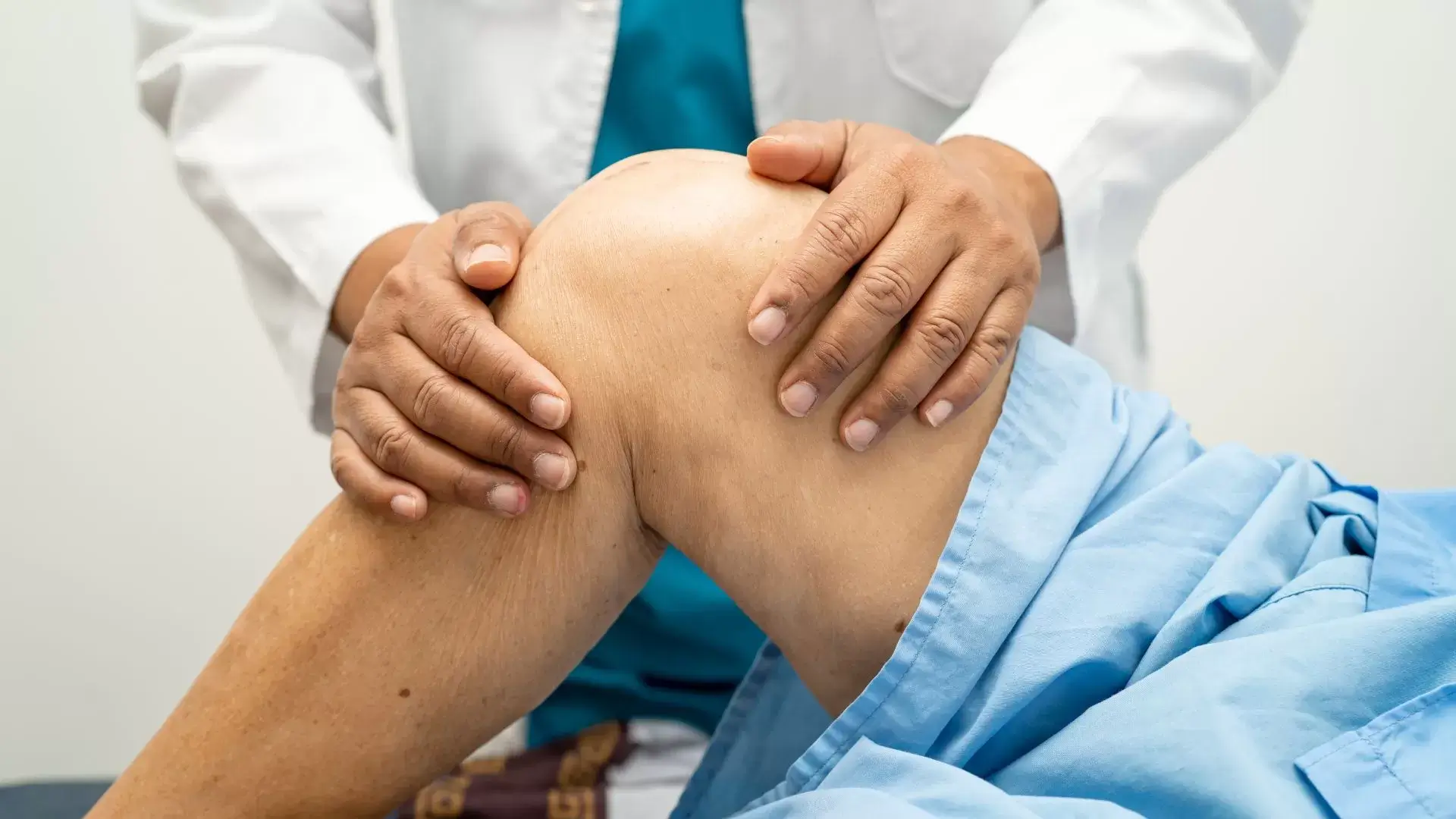Physiotherapy for Joint Replacement is essential for recovery after joint replacement surgery in Mississauga. We comprehend that physiotherapy plays a crucial role in the healing process. Our programs focus on regaining strength, mobility, and confidence through structured rehabilitation tailored to each individual’s needs. We emphasize targeted exercises to improve range of motion and strengthen the muscles around the new joint. Early movement is encouraged to minimize complications, and gait training helps guarantee safer mobility. We also provide education on pain management and the use of assistive devices. If you’re looking for the best strategies to support your healing journey, there’s more we can share about our tailored approach.

At Mississauga Physio Chiro Clinic, we offer extensive physiotherapy and chiropractic services tailored to support your recovery after joint replacement surgery. We recognize that postoperative rehabilitation is vital for regaining strength and mobility. Our Dedicated Physiotherapist & Chiropractor in Mississauga will conduct a thorough preoperative assessment to design a personalized rehabilitation plan that addresses your unique needs.
Our approach includes joint strengthening exercises aimed at enhancing stability and function. We also focus on pain management techniques to help alleviate discomfort and promote inflammation reduction. Range of motion exercises are integral to restoring flexibility, while weight-bearing exercises will help you gradually regain independence and confidence in your movements.
Additionally, we provide guidance on using mobility aids effectively, guaranteeing you navigate your environment safely. Our holistic approach to long-term joint care emphasizes the importance of maintaining your joint health well beyond the initial recovery phase.
Together, we’ll work towards achieving your rehabilitation goals, empowering you to return to an active lifestyle. With our expertise in physiotherapy and chiropractic services, we’re here to guarantee you receive the all-encompassing support you need on your journey to recovery.
What can we expect from joint replacement surgery and the subsequent recovery process? Joint replacement, specifically total joint replacement, is an orthopedic surgery designed to alleviate severe joint pain and restore function. This procedure is often recommended for individuals experiencing mobility loss due to conditions like post-traumatic arthritis or degenerative joint diseases.
After surgery, we typically enter a rehabilitation phase that focuses on regaining strength and mobility. Physical therapy plays an important role during this time, guiding us through exercises tailored to our specific needs. It’s vital to understand that recovery can vary, with some of us requiring assistive devices such as walkers or crutches initially.
We’ll also need to embrace joint preservation strategies to protect our new joint and enhance longevity. This might include lifestyle modifications and ongoing physical therapy to maintain flexibility and strength. While the journey may have its challenges, our dedication to rehabilitation and adherence to the prescribed therapy can greatly improve our outcomes. Ultimately, the goal is to alleviate joint pain, restore mobility, and enhance our overall quality of life.
Physiotherapy plays an essential role in our recovery journey after joint replacement, helping us regain strength, mobility, and confidence through tailored exercises and support. Following procedures like joint arthroplasty or partial joint replacement, we often face challenges such as joint stiffness and muscle atrophy. A structured rehabilitation program guided by a physiotherapist is crucial in overcoming these obstacles.
Through targeted exercises, we can improve our range of motion and strengthen the muscles surrounding the prosthetic joint. Gait training is a key component of our rehabilitation, as it helps us relearn how to walk properly, reducing the risk of falls and further injury. Additionally, physiotherapists offer valuable advice on lifestyle modifications to facilitate our recovery, ensuring we adapt our daily activities to support healing.
Swelling control techniques, including ice therapy and compression, are also emphasized to minimize discomfort and promote healing. Occupational therapy may be integrated into our care, assisting us in performing daily tasks with greater ease. Overall, the collaborative approach of physiotherapy not only aids in physical recovery but also empowers us to regain independence and improve our quality of life post-surgery.
Preparing for joint replacement surgery through pre-surgery physiotherapy can greatly enhance our overall recovery outcomes by building strength and improving mobility beforehand. For those of us dealing with osteoarthritis, chronic joint pain, or joint degeneration, engaging in targeted exercises can help mitigate joint instability.
By focusing on building strength prior to surgery, we can improve our bone density, which is vital for a successful joint replacement. Pre-surgery physiotherapy not only prepares our muscles and joints for the upcoming procedure, but it also aids in scar tissue management. This is particularly important if we’re opting for minimally invasive joint replacement techniques, as it can lead to quicker recovery times.
Additionally, participating in a structured physiotherapy program allows us to learn effective exercises and strategies that we can continue post-surgery. With the guidance of a skilled physiotherapist, we can address any concerns and set realistic goals for our recovery journey. By investing time in pre-surgery physiotherapy, we’re not just preparing our bodies for surgery; we’re setting ourselves up for a smoother, more successful rehabilitation phase.

Early post-surgery rehabilitation is essential for regaining mobility and function, allowing us to shift smoothly from the surgical recovery phase to active rehabilitation. After procedures like hip replacement, knee replacement, or shoulder replacement, our focus should be on restoring joint function and minimizing the risk of complications such as deep vein thrombosis and infection.
During this vital period, we’ll work closely with our physiotherapists to develop tailored rehabilitation plans. These plans often include gentle exercises aimed at increasing mobility and addressing any loss of joint function caused by cartilage damage. It’s important to start these exercises as soon as we’re cleared by our healthcare team, as early movement can greatly enhance our recovery.
We’ll also be educated about proper techniques to prevent strain on the healing joint, ensuring we progress safely. Regular follow-ups will help us monitor our progress and adjust our rehabilitation strategies as needed. By committing to this early rehabilitation phase, we not only improve our chances of a successful recovery but also empower ourselves to regain independence and return to our daily activities with confidence.
Managing pain effectively after joint replacement is vital for our recovery journey, as it allows us to engage more fully in rehabilitation and daily activities. After procedures like elbow replacement, ankle replacement, or wrist replacement, we often face discomfort that can hinder our progress.
Utilizing a combination of pain management techniques can greatly enhance our recovery experience. Anti-inflammatory medications can help reduce swelling and pain, while corticosteroid injections may provide targeted relief for specific joint areas. Hyaluronic acid injections are another option that can lubricate the joint, potentially alleviating pain associated with prosthetic loosening.
In addition to medication, we can incorporate both heat and cold therapy into our routine. Cold therapy helps minimize swelling immediately post-surgery, while heat therapy can ease muscle tension in the later stages of recovery. These methods not only provide physical relief but also contribute to our overall well-being.
It’s important to communicate with our healthcare team about our pain levels and any adjustments needed in our pain management plan. By proactively addressing pain, we’re setting ourselves up for a more successful rehabilitation process and a better quality of life post-surgery.
As we focus on effective pain management, it’s equally important to prioritize enhancing flexibility and restoring range of motion after joint replacement to support our overall recovery and functional abilities. Following a joint replacement, many of us experience stiffness and decreased flexibility, which can hinder rehabilitation efforts. Physiotherapy plays a significant role in addressing these issues.
Through targeted exercises, we can gently stretch and mobilize the affected joint, gradually improving our range of motion. This is particularly essential for those who have undergone procedures related to osteoarthritis or degenerative joint disease, as it helps prevent complications like implant wear and increases our overall stability.
Additionally, restoring flexibility not only aids in daily activities but also greatly reduces the risk of future fractures and ligament damage. By focusing on these aspects during our rehabilitation journey, we set ourselves up for long-term success and improved quality of life. Engaging in consistent physiotherapy sessions, guided by professionals, allows us to regain the mobility we need to enjoy activities we love while minimizing the impact of joint-related issues.
To enhance joint stability after replacement, we must incorporate targeted strengthening exercises into our rehabilitation routine. These exercises are essential for supporting the artificial joint and ensuring that the surrounding muscles can effectively stabilize the implant. By focusing on specific muscle groups, we can reduce the risk of joint deformity and minimize the chances of tendon damage, which can occur due to weakened muscles.
Moreover, targeted strengthening exercises play an important role in blood clot prevention, especially following joint replacement surgery. They promote circulation and enhance overall mobility, which is critical for those recovering from revision joint surgery or dealing with conditions like osteoporosis. We should gradually increase the intensity of these exercises, always keeping in mind our individual recovery timelines and limitations.
Incorporating resistance training, we can improve joint stability and overall function. We’ll also consider exercises that target the hip, knee, and ankle, as they work synergistically to support our new joint. By committing to this focused rehabilitation approach, we can foster a smoother recovery, ultimately leading to improved quality of life and greater independence.

Building on our focus on targeted strengthening exercises, gait training and balance improvement are fundamental components of rehabilitation that enhance mobility and reduce the risk of falls after joint replacement. In our physiotherapy sessions, we prioritize these aspects to guarantee a smooth post-surgery recovery.
Gait training involves structured mobility exercises designed to help patients regain their walking patterns and improve their confidence while moving. By incorporating strength training, we address muscle imbalances that may affect stability. Our tailored approach guarantees that each patient progresses at their own pace, fostering a sense of achievement and independence.
Balance improvement techniques play a significant role as well. We utilize various exercises to enhance proprioception and coordination, which are essential for safer mobility. Through patient education, we empower individuals to understand their bodies better and recognize the importance of maintaining balance in daily activities.
Using assistive devices can greatly enhance our recovery process and promote safer movement for individuals after joint replacement surgery. At 1834 Lakeshore Rd W unit 6C, Mississauga, ON L5J 1J7, we find that utilizing tools like walkers, crutches, or canes allows us to regain our independence while minimizing strain on the joint implant. These devices not only support our physical stability but also build confidence as we progress through physiotherapy.
After a robotic-assisted joint replacement or procedures involving uncemented implants and bone grafting, integrating assistive devices into our daily routines becomes essential. They aid in managing weight distribution and can considerably reduce the risk of falls during the initial stages of recovery.
As we work closely with our physiotherapists, we’ll learn how to properly use these devices to improve our movement patterns. This guidance guarantees that we’re using assistive devices effectively while adhering to the prescribed rehabilitation plan. By embracing these tools, we’re taking proactive steps towards a successful recovery, setting the foundation for better mobility and overall well-being in our post-surgery lives.
To maintain joint health over the long term, we should adopt a proactive lifestyle that includes regular exercise, a balanced diet, and ongoing physiotherapy. This helps us not only recover but also thrive after joint replacement surgery.
When considering our implants, whether it’s a metal-on-metal implant, ceramic-on-ceramic implant, or metal-on-polyethylene implant, we need to be aware of how they affect our joint health. Each type has its unique benefits and potential drawbacks, which we can discuss with our healthcare provider. Staying informed about our specific implant can guide our lifestyle choices.
Regular exercise strengthens the muscles around our joints, improving stability and flexibility. We should focus on low-impact activities like swimming or cycling to protect our joints. A balanced diet rich in antioxidants and omega-3 fatty acids can reduce inflammation and promote overall joint health.
For personalized advice and ongoing support, we can reach out to professionals. They can help us create a tailored exercise program and provide tips on maintaining a healthy lifestyle as we navigate our post-surgery journey. Together, we can guarantee a healthier future for our joints.
Customized physiotherapy approaches are essential for optimizing recovery and function after different types of joint replacements, as each procedure presents unique challenges and goals. When we consider knee, hip, or shoulder replacements, we recognize that the rehabilitation process must be tailored to the specific joint and the individual’s needs.
For knee replacements, our focus is on restoring range of motion and strength through targeted exercises that emphasize flexibility and stability. We often incorporate balance training to enhance mobility and prevent falls. In the case of hip replacements, we prioritize safe movement patterns and core strengthening, ensuring that our patients feel confident as they return to daily activities.
Shoulder replacements require a distinct approach, as we concentrate on regaining overhead movement and functional strength. Here, we emphasize exercises that promote scapular stability and shoulder mobility.
Continued physiotherapy plays an essential role in maintaining joint health and preventing complications, ensuring that our patients can enjoy an active lifestyle long after their replacement surgery. As we progress through our recovery, it’s imperative to recognize that the journey doesn’t end with initial rehabilitation. Ongoing physiotherapy helps us strengthen the surrounding muscles, improve flexibility, and enhance overall function.
Regular sessions allow us to monitor our joint’s performance and adjust exercises as needed. This proactive approach not only reduces the risk of stiffness and pain but also promotes proper movement patterns, which can prevent future injuries. By committing to continued physiotherapy, we’re actively participating in our long-term health and well-being.
Additionally, physiotherapy empowers us with knowledge about our bodies and how to care for our joints effectively. We learn strategies to manage any discomfort and maintain an active lifestyle, which is essential for emotional well-being. Ultimately, embracing continued physiotherapy is not just about recovery; it’s about investing in our future, ensuring that we can remain engaged in the activities we love for years to come.
For those seeking effective support in their recovery journey, specialized physiotherapy for joint recovery in Mississauga offers tailored strategies to enhance healing and regain mobility. We recognize that each individual’s needs are unique, and our dedicated team of physiotherapists is committed to developing personalized treatment plans that address specific concerns and goals.
Our approach combines hands-on techniques, exercise therapy, and education to guarantee that we not only facilitate physical recovery but also empower you with the knowledge to manage your condition effectively. By integrating advanced methods and evidence-based practices, we aim to maximize your recovery potential, helping you return to the activities you enjoy most.
We know that the road to recovery can be challenging, and we’re here to support you every step of the way. By fostering a compassionate environment, we encourage open communication, allowing us to adjust your treatment as needed and celebrate your progress.
If you’re ready to take the next step towards regaining your mobility and improving your quality of life, don’t hesitate to contact us. Together, we’ll work towards achieving your recovery goals with confidence and care.
Nestled in the heart of the Greater Toronto Area, Mississauga is a vibrant city known for its diverse population and rich cultural offerings, making it an ideal place for residents seeking extensive healthcare solutions. With a variety of healthcare facilities, including specialized physiotherapy clinics, we have access to thorough support for our joint replacement journeys.
The city boasts a well-connected infrastructure, enabling easy access to medical services and rehabilitation programs. Its multicultural environment guarantees that healthcare providers are attuned to the unique needs of various communities, fostering a sense of inclusivity and understanding. Here, we can find practitioners who are not only skilled but also empathetic, recognizing the challenges of recovery after surgery.
In Mississauga, we benefit from a wealth of resources, including parks, recreational centers, and wellness programs that promote physical activity and overall health. As we navigate our recovery, it’s reassuring to know that we have a supportive community and specialized services right at our doorstep. Together, we can embrace a healthier future, empowered by the city’s commitment to our well-being and the expertise of our local healthcare professionals.

When considering qualifications for our physiotherapist, we should look for a licensed professional with a degree in physiotherapy and specialized training in post-surgical care. It’s important they have experience working with joint replacement patients and familiarity with evidence-based rehabilitation techniques. We might also want to check for certifications in orthopedics or relevant continuing education. A compassionate approach and good communication skills are essential, as they’ll guide us through our recovery journey effectively.
After joint replacement surgery, we typically need physiotherapy for several weeks to months, depending on our individual recovery progress. Generally, we can expect to attend sessions two to three times a week initially, gradually reducing frequency as we regain strength and mobility. It’s crucial to listen to our bodies and communicate with our physiotherapist about any concerns, ensuring a tailored approach that supports our healing journey effectively.
When recovering from surgery, it’s essential to avoid specific exercises that could jeopardize our healing. High-impact activities, deep squats, and twisting motions can place undue stress on our joints. We should also steer clear of anything that causes pain or discomfort. Instead, we can focus on gentle range-of-motion and strengthening exercises recommended by our healthcare provider, ensuring we’re progressing safely and effectively in our recovery journey. Listening to our bodies is key.
Tracking our progress during rehabilitation can be motivating and vital for our recovery. We can keep a daily journal to document our exercises, pain levels, and improvements in mobility. Using apps or wearables can help us monitor our activity and set goals. Regular check-ins with our healthcare provider will guarantee we’re on the right path. Reflecting on our achievements, no matter how small, reinforces our commitment and encourages us to stay focused on our goals.
If we experience setbacks in our recovery, it’s important to stay calm and reassess our approach. We should communicate openly with our healthcare team about what we’re feeling, as they can provide guidance tailored to our situation. It’s also essential to remember that setbacks are a natural part of the healing process. By adjusting our goals and focusing on small, achievable steps, we can regain our momentum and continue on our path to recovery.
Reach out to us today to book an appointment or learn more about our services. Our friendly team is here to answer your questions and help you take the first step toward improved health and wellness.
(647) 372-1209

At our “Mississauga Physio Chiro Clinic”, we are dedicated to providing personalized care that addresses the root cause of your discomfort. With a team of experienced physiotherapists and chiropractors, we focus on restoring your mobility, relieving pain, and enhancing your overall well-being.